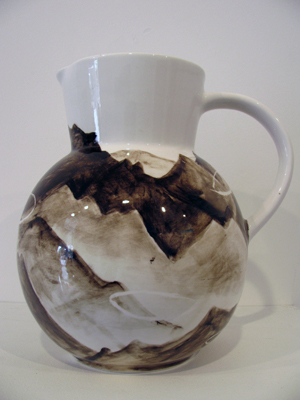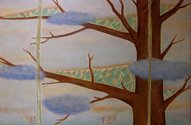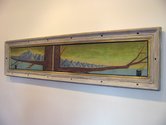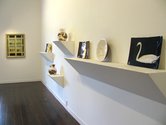John Hurrell – 6 June, 2010
There is no adventurous compositional organisation within the rectangular stretchers, only a somewhat predictable wooden and awkward positioning. Within this though, we have a symbolism of dry hilly landforms sustained by the spread branches of a tree. It holds up these landscapes and has a life force streaming vertically through it. Or as in another work, different worlds set in the panes of a gridded window frame.
This is one of those shows where I much prefer the artist’s painted and fired ceramics to the decoratively framed oil paintings that they are famous for. The chinaware, which consists of jugs, platters and slab dishes, is delicate and nuanced while the paintings on linen seem coarse and clumsy. One is fluid and flowing while other is scumbled and scrubby.
If I was inclined to enthuse over painted spiritual symbolism I might gravitate toward McCahon, or perhaps Pauline Thomson and Stanley Spencer - more than this painter: though the last two are a little ‘sweet’ for my modernist tastes. Tony Lane I simply find too languid with the sleepy flaccid line he adapted from eighties Transavantgardia Italians like Palladino or Chia and made a signature style from.
Lane’s sense of design seems to lack a sense of dynamic placement where the frame is an active field conscious of its edges. There is no adventurous compositional organisation within the rectangular stretchers, only a somewhat predictable wooden and awkward positioning. Within this though, we have a symbolism of dry hilly landforms sustained by the spread branches of a tree. It holds up these landscapes and has a life force streaming vertically through it. Or as in another work, different worlds set in the panes of a gridded window frame.
How does one interpret the various angular and barren hills held up by the boughs of a tree? Are they a symbols of a solid material (as in molecular) foundation or are they about ethical values? Or are they about the nature of life itself, signs of the flimsiness and transience of our bodily existence?
Why are the china jugs in particular so much better? They work differently because as symbolic glossy vessels (referencing perhaps the Virgin Mary, reincarnated bodies or human minds in general) the interaction between form and applied to surface is lively, more tangible and less predictable - especially in the way Lane’s Chinese influenced brushed-on images deal with the peculiarities of the bulbous support. In this sense Lane is much like Martin Poppelwell (another Bibby artist) whose painted ceramics are also infinitely more interesting than his painting. With their dark fluid forms glowing with the underpainting peeking through (as suggested by the title), the edges of Lane’s drawn shapes seem to vibrate. They look quickly made and spontaneous. They surprise with their invention.
John Hurrell







 Advertising in this column
Advertising in this column Two Rooms presents a program of residencies and projects
Two Rooms presents a program of residencies and projects



This Discussion has 0 comments.
Comment
Participate
Register to Participate.
Sign in
Sign in to an existing account.